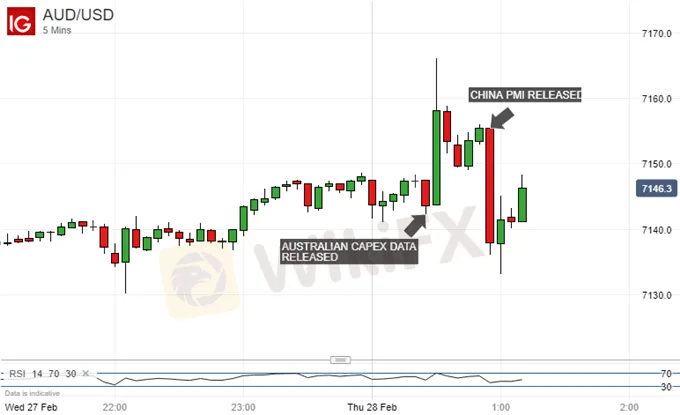简体中文
繁體中文
English
Pусский
日本語
ภาษาไทย
Tiếng Việt
Bahasa Indonesia
Español
हिन्दी
Filippiiniläinen
Français
Deutsch
Português
Türkçe
한국어
العربية
Australian Dollar Wilts As China Manufacturing PMI Contracts Again
Abstract:The Australian Dollar had been bouyed up by strength in domestic capital spending but it fell back sharply on news that Chinese manufacturing contracted once
Australian Dollar, China Purchasing Managers Index, Talking Points:
A key gauge of Chinas manufacturing health was weak for yet another month
AUD/USD reversed sharply in the aftermath
Hopes of a trade settlement between China and the US may have limited damage
First-quarter technical and fundamental forecasts from the DailyFX analysts are out now.
The Australian Dollar slipped sharply Thursday on the news that Chinas manufacturing sector contracted for a third straight month in February.
The country‘s official Purchasing Managers Index came in at 49.2, below both the 49.5 which had been both January’s print and the expected February result. This series has now been below the 50 mark which separates expansion from contraction since December.
The non-manufacturing PMI was in the green, however. It came in at 54.3, for a composite of 52.4, but the weakness in manufacturing weighed heavily nonetheless.
The Australian Dollar can act as the markets‘ favorite liquid China proxy given Australia’s close export links to the world‘s second largest economy. It seems to have done so Thursday, with the China data more than erasing gains made earlier when Australia’s fourth-quarter private capital expenditure data smashed forecasts by rising 2% when a 0.5% gain had been tipped.
Chinas numbers may need a grain of salt. The Lunar New Year break may well have weakened activity. However, they come after a raft of similarly weak numbers from around the world, and notably out of Europe, and are likely to be seen as further evidence that the global economy is slowing.

This is likely to be especially bad news for the Australian currency which is typically quite sensitive to world growth prospects.
That said the Aussie remains in a broad range against its US big brother. The currency was hit earlier this month by the Reserve Bank of Australias admission that record-low domestic interest rates could yet fall further. Futures markets had been pricing in just such a possibility since late 2018, but the RBA had previously stuck to its view that the next move was likely to be a rise, albeit not any time soon.
The central bank also slashed the growth and inflation forecasts on which its policy rests. For all that AUD/USD remains above the downtrend which dominated last years trade. Growing optimism for a trade settlement between China and the US has helped; Australia probably has as much skin in that game as any third country. A deal is probably the biggest single near-term risk currently run by Australian Dollar bears.

Increased caution around the path of US intertest rates has weakened the USD side of the pair, while strong Australian employment numbers also helped Aussie bulls cause.
Disclaimer:
The views in this article only represent the author's personal views, and do not constitute investment advice on this platform. This platform does not guarantee the accuracy, completeness and timeliness of the information in the article, and will not be liable for any loss caused by the use of or reliance on the information in the article.
WikiFX Broker
Latest News
IEXS Review 2025: A Complete Expert Analysis
IEXS Regulation: A Complete Guide to Its Licenses and Safety Warnings
【WikiEXPO Global Expert Interviews】Ashish Kumar Singh: Building a Responsible and Interoperable Web3
CySEC Flags 21 Unauthorized Broker Websites in 2025 Crackdown
CQG Partners with Webull Singapore to Power the Broker’s New Futures Trading Offering
WinproFx Withdrawal Problems: A Complete Look at Delays and User Reports
Factory Orders Data Show Rebound In August
Interactive Brokers Expands Access to Taipei Exchange
Simulated Trading Competition Experience Sharing
WinproFx Regulation: A Complete Guide to Its Licensing and Safety for Traders
Currency Calculator



